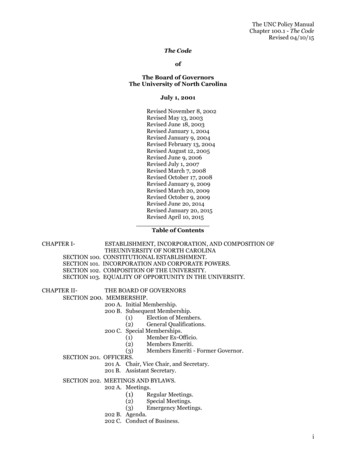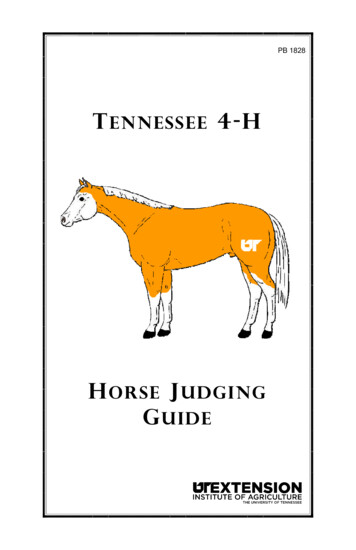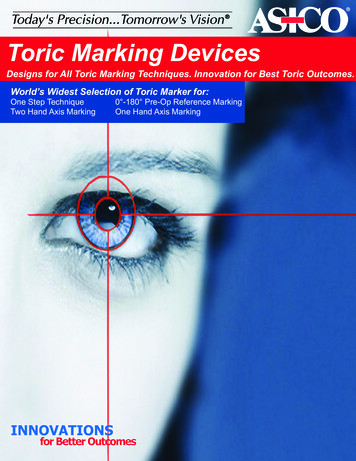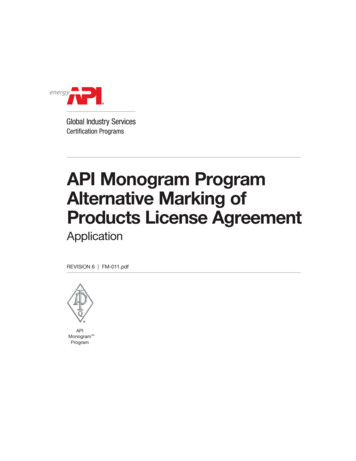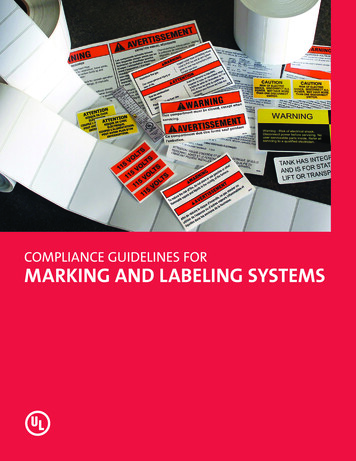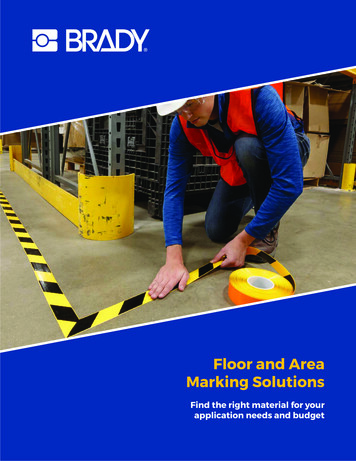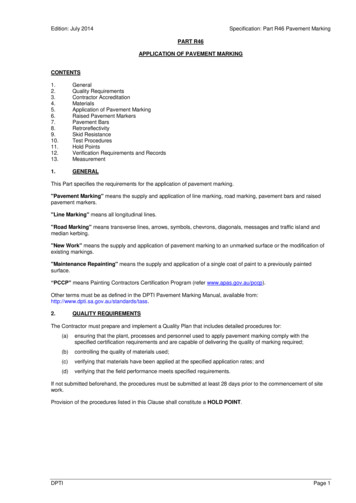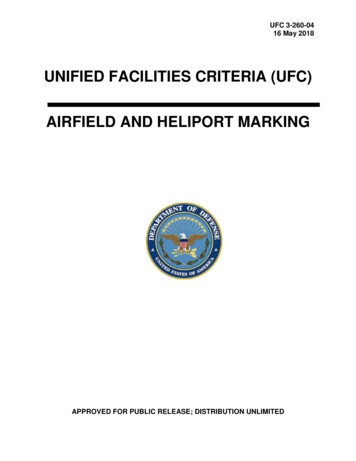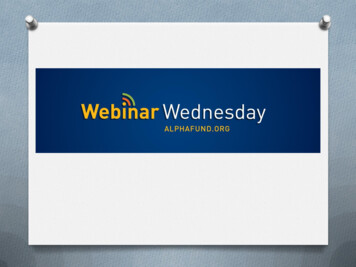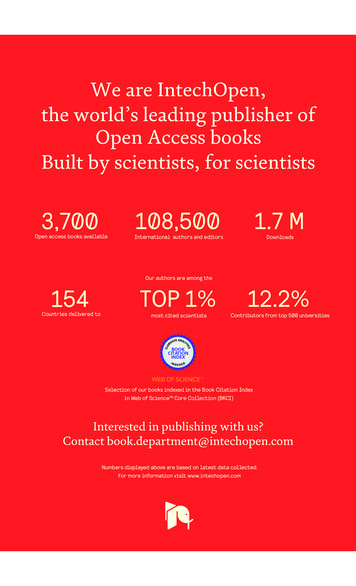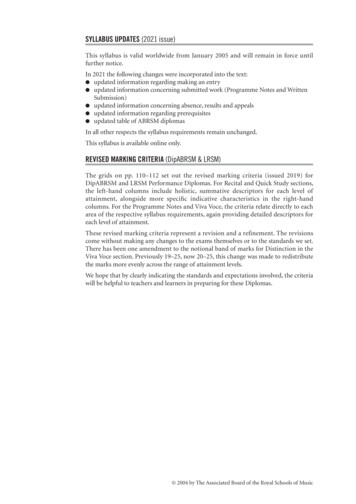
Transcription
SYLLABUS UPDATES (2021 issue)This syllabus is valid worldwide from January 2005 and will remain in force untilfurther notice.In 2021 the following changes were incorporated into the text: updated information regarding making an entry updated information concerning submitted work (Programme Notes and WrittenSubmission) updated information concerning absence, results and appeals updated information regarding prerequisites updated table of ABRSM diplomasIn all other respects the syllabus requirements remain unchanged.This syllabus is available online only.REVISED MARKING CRITERIA (DipABRSM & LRSM)The grids on pp. 110–112 set out the revised marking criteria (issued 2019) forDipABRSM and LRSM Performance Diplomas. For Recital and Quick Study sections,the left-hand columns include holistic, summative descriptors for each level ofattainment, alongside more specific indicative characteristics in the right-handcolumns. For the Programme Notes and Viva Voce, the criteria relate directly to eacharea of the respective syllabus requirements, again providing detailed descriptors foreach level of attainment.These revised marking criteria represent a revision and a refinement. The revisionscome without making any changes to the exams themselves or to the standards we set.There has been one amendment to the notional band of marks for Distinction in theViva Voce section. Previously 19–25, now 20–25, this change was made to redistributethe marks more evenly across the range of attainment levels.We hope that by clearly indicating the standards and expectations involved, the criteriawill be helpful to teachers and learners in preparing for these Diplomas. 2004 by The Associated Board of the Royal Schools of Music
CONTENTS3 INTRODUCTION56101317CONTENT OF THE MUSIC PERFORMANCE DIPLOMASOverviewDipABRSMLRSMFRSMSummary of skills, knowledge and understanding at all levelsPREREQUISITES AND SUBSTITUTIONS19 Prerequisites and substitutions21 Appropriate professional experienceSUBMITTED WORK23 General information regarding submitted work24 Programme Notes (DipABRSM and LRSM)25 Written Submission (FRSM)28293031PRACTICALITIESBefore the exam (Entry)On the day of the examAfter the examOther mattersREPERTOIRE LISTS34 Instrumental and vocal repertoire lists95 Orchestral excerpts for FRSM97 Accepted related instruments99109114116117APPENDICESAppendix 1: Specimen questions and indicative responsesAppendix 2: Marking criteriaAppendix 3: Application form for appropriate professional experience approvalAppendix 4: Exam musicAppendix 5: Regulation (UK)118 INDEX
3INTRODUCTIONABRSM’s diplomas provide an authoritative assessment framework for a wide range ofmusicians – performers, directors and teachers. Whether you are intending to pursue acareer in music, are currently working as a professional and wish to broaden yourqualifications, or are purely after the satisfaction of achieving a personal goal, you willfind that one of our diplomas is right for you.There are three diploma subject-lines – Music Performance, Music Direction, andInstrumental/ Vocal Teaching. Each subject-line has three levels of award:DipABRSMLRSMFRSMDiploma of The Associated Board of the Royal Schools of MusicLicentiate of the Royal Schools of MusicFellowship of the Royal Schools of MusicThe requirements within each subject-line at each level are generally comparable,and the syllabus for each subject-line is available separately (online only atwww.abrsm.org/diplomas).Encouraging diverse approaches to the performing, directing and teaching of music, thediplomas stimulate enjoyment and achievement through the progressive acquisitionof skills, knowledge and understanding. As a result, their usefulness has beenacknowledged by music services and agencies around the world. They are compatiblewith systems of assessment widely applied in higher education and encourage lifelonglearning, without restrictions on length of study or the requirement that you, thecandidate, are taught in an institution. They are regulated in various countriesworldwide.The Music Performance diplomas are designed to reflect your day-to-day experience as aperformer, whether amateur or professional. As well as demonstrating your skills as asoloist, from LRSM level there is the opportunity for you to specialise as an orchestralplayer, chamber ensemble member or keyboard accompanist. There are also options, atall three levels, to perform on an instrument related to your main instrument for a partof your Recital and to perform repertoire of your own choice. The following tasks areincluded:compiling a balanced recital programme, finding editions that suit yourinterpretation best, and writing about the music talking with confidence about the music and the way you interpret it sight-reading at short notice to a reasonable standard (Quick Study) putting on the best possible performance on the day. You will need to satisfy the examiners that you have a command of your choseninstrument in the context of Western art music. (Throughout this syllabus, the term‘instrument’ is used to include ‘voice’.) As you move up through the diploma levels you willfind that the repertoire becomes more demanding, the Recital time lengthens, and thechallenge of the Quick Study, and the scope and length of your written work, increase. Ateach level you will be assessed according to the overall quality of your performance, as wellas your understanding of and sensitivity to the demands of different types of repertoire.In order to establish basic levels of competence, a specific prerequisite is required beforeentry can be made to any level. However, in line with our aim to provide open accessand to recognise your achievements, we offer a range of substitutions for theseprerequisites, including your previous learning and experience. The prerequisites andtheir substitutions are listed in the tables on pp. 19–20. They are also to be found on ourwebsite (www.abrsm.org/diplomas), where any substitutions appearing after the issueof this syllabus will also be listed. We hope that you find the experience of taking one ofour diplomas stimulating, challenging and worthwhile, both during the period ofpreparation and in the exam itself.
5 Overview6 DipABRSM10 LRSM13 FRSM17 Summary of skills, knowledge and understanding at all levelsDIPLOMA CONTENTCONTENT OF THEMUSIC PERFORMANCEDIPLOMAS
5OVERVIEWDIPLOMA CONTENTOverviewThe Music Performance diplomas are available to instrumental and vocal performers.Through live and written components, you, the candidate, will be examined in yourcommand of performance technique and interpretative skill coupled with anappropriate knowledge of the idiom and repertoire of your instrument/voice.The diplomas are conducted in English (see p. 32).Before you can enter for a Music Performance diploma, you will need to show that youfulfil a specific ABRSM prerequisite as evidence that you have reached a requiredminimum level of competence. The table on pp. 19–20 lists the prerequisites and theirpossible substitutions.Each level of diploma comprises a number of requirements that you must satisfyin full. The requirements are divided into two sections, as outlined below. You must passall the requirements of both sections in order for your diploma to be awarded.The requirements must be met in full within three years.SECTION 1 an instrumental or vocal Recital.SECTION 2 Section 2.1 a Viva Voce, entailing a discussion with the examiners. a written assignment (relating to your Recital programme) which you should beprepared to discuss as part of your Viva Voce, and which contributes to the Viva Vocemark. At DipABRSM and LRSM levels, this assignment takes the form ofProgramme Notes, which must be presented to the examiners on the day of theexam. At FRSM level, you are required to prepare a Written Submission, which youmust send to ABRSM with your entry.Section 2.2 a Quick Study – performance of a short piece of unaccompanied and previouslyunseen music.Full descriptions of each level of diploma, including preparation guidance, are given onthe following pages. All practical information about taking a diploma is described inPracticalities (pp. 27–32).
DipABRSM General information/Section 1To be submitted on Two copies of Programme Notes, written by you and illuminating in your own wordsthe day of the exam the repertoire you have chosen to perform in your Recital. The steward will take yourProgramme Notes following your arrival at the exam venue to pass to the examiners.Full details regarding the Programme Notes, including length, are given on pp. 23–25.10%) are devotedTiming 60 minutes are allocated to the DipABRSM, of which 35 minutes ( to the Recital, up to 12 minutes to the Viva Voce and up to 10 minutes to the QuickStudy.SECTION 1 RECITALDuration You should plan your Recital so that it lasts approximately 35 minutes (it may be up to10% longer or 10% shorter). This total duration includes any breaks between items, aswell as one longer pause (of up to 5 minutes) for woodwind, brass and singingcandidates. Please note that the examiners reserve the right to stop the Recital if youexceed the prescribed duration.Programming Your programme should be largely drawn from the prescribed lists of instrumental andvocal works or movements given on pp. 34–95. You may, however, also include in yourprogramme a work or works of your own choice not listed on these pages butcomparable in standard and lasting no more than 7 minutes in total; prior approvalfrom ABRSM is not required for any such alternative items. Please note that performingown-choice repertoire gives no advantage over candidates presenting syllabus-listeditems only.In your choice of repertoire, you should aim to present a generalist programme thatoffers a wide-ranging yet coherent mixture of periods, style, mood and tempo, with nomore than one work by any single composer (except for vocal items or where acombination of movements or pieces from a composer’s collection is indicated in theprescribed lists). You should be able to demonstrate musical technique and perceptionat a level worthy of public performance and appreciation.Exam music The editions quoted in the repertoire lists on pp. 34–95 are recommendations only, andyou are free to choose any other editions. All works/movements must be performedcomplete, although you should use your discretion in matters such as the omission oftutti sections or the inclusion of cadenzas in concerto movements or other works.The observance of repeats and interpretative decisions such as phrasing and therealisation of ornaments are also matters in which you are expected to use yourdiscretion to achieve a stylistically appropriate and musically satisfying performance.Please note that on the day of the exam you will need to provide the examiners withcopies of all the music you are performing, ideally in the same editions as those you areusing (for pieces which are accompanied by piano, a copy of the piano score should besupplied). (If photocopies are to be used for this purpose, it is your responsibility toobtain written permission from the publisher/copyright holder. In the UK, certainpublishers allow photocopies to be made for the examiners’ use – for full details, see theMPA’s Code of Fair Practice at www.mpaonline.org.uk.)Performing Although there is no specific requirement to perform from memory, you arefrom memory encouraged to do so if you consider it will enhance your Recital. In particular, singersare advised to perform their programme from memory, with the exception of oratorio/sacred items and complex contemporary scores.DIPLOMA CONTENTPrerequisite ABRSM Grade 8 (Practical or Performance) in the instrument presented or a permittedsubstitution (see p. 19).6
DipABRSM Section 1DIPLOMA CONTENT7Accompanists and You must provide your own accompanist, where appropriate. The accompanist maypage-turners remain in the exam room only while actually engaged in accompanying. Please notethat examiners will not act as accompanists under any circumstances. Both you andyour accompanist may bring a page-turner, if required. In the case of organ candidates,the page-turner may also act as registrant.Equipment All ABRSM public venues provide a music stand, but you are welcome to bring yourown if you prefer. You are recommended to bring your own stool, if required. You maynot bring into the exam room any material or equipment unconnected with your exam;any infringement of this rule may lead to disqualification.Related instrument If your instrument is one of those listed under ‘Main Instrument’ in the table on p. 97,option you have the option to play one work of your Recital on a related instrument (these arealso listed on p. 97), while ensuring that the majority of the programme is performed onyour main instrument. Please note that there is no advantage to be gained over othercandidates by offering a work on a related instrument.Other requirements Candidates not meeting the syllabus requirements in any way, such as offering aninappropriate standard of piece, failing to adhere to the minimum/maximum platformtimes, or not being prepared to perform the minimum number of movements/pieces orthe whole of a work if specified in the syllabus, will be liable to penalty.SECTION 1PREPARATION GUIDANCE FOR RECITALOn the day of the exam, establish your stage presence right at the outset. Displayingconfidence in entering the exam room, settling in and allowing yourself time to pauseand create a space around each item will all increase the impact of your Recital.The marking criteria in Appendix 2 will help you to understand what qualities theexaminers are looking for in your performance. The balance of technical and musicalattainment shown through your instrumental ability, and your communication throughmusicianship, personal insight, interpretative skill and stage presence, are what count.It may help to imagine that the Recital is for performance on the radio or at a publicvenue.Although you are not required to perform from memory, you should consider thestandard convention for your instrument. For example, solo pianists normally performrecitals from memory (while it is unusual for a pianist playing within a chamberensemble to do so without the music). In every case, the overriding priority must be themusic itself and your communication and interpretation of it in a professional context.For singers, reference to the sheet music in performance may not only be inhibiting butcan act as a barrier to the communication and interpretation of the music and themeaning of the text. Singers are therefore advised to use the sheet music only in oratorioitems or complex contemporary works, in line with common performance practice.In preparing for the exam, you may find it helpful to attend recitals on a regular basis inorder to learn from approaches taken by professional performers. Critical listening andcomparison of interpretations on record, combined with reading about performancetechniques and practices, will also be useful. There is a list of recommended texts onthe ABRSM website (www.abrsm.org/diploma-preparation). Finally, get to know notonly the pieces within your programme but also their general context within eachcomposer’s output and the musical era.
DipABRSM Section 2The Viva Voce is an opportunity for you to demonstrate your knowledge, approach andunderstanding to the examiners. Questions will cover your Recital and yourProgramme Notes, as well as other aspects of performing. The Viva Voce lasts up to12 minutes.Typical areas of discussion in the Viva Voce: SECTION 2.1Musical and instrumental outlook: questions designed to put you at ease and tolead into the discussion, including: choice of repertoire, the challenges presentedand the preparation involved; knowledge of the underlying concepts and principlesassociated with your instrument.Repertoire and Programme Notes: knowledge of the repertoire performed,including biographical information about each composer and the context of eachwork in the composer’s life and output; details of commission (if any); the process ofcomposition and first performance; knowledge of the general musical trends of theera and the place of each work in the context of the core repertoire.Musical language and form: understanding of the structure of each work and thefeatures of its musical language.Style and interpretation: understanding of style and technique; knowledge of eachwork in the context of the instrument itself: historical developments, idiom, corerepertoire and technical demands; the interpretation of notation and ways tocommunicate the composer’s intentions; performance practices including originalinstrumentation; approaches to performance, including the use of physical space,memory and communication with an audience.Any further points you wish to draw to the examiners’ attention before theconclusion.PREPARATION GUIDANCE FOR VIVA VOCEThe tone and manner of the Viva Voce will be as relaxed as possible and the examinerswill make every effort to put you at ease. The opening questions will be informal,progressing to topics on which you are likely to be knowledgeable, then on to morechallenging questions. All the questions will be clearly and directly expressed by theexaminers; some will be open-ended, others will be more specific. You will not bepenalised if you ask for clarification of a question, and the examiners will not beconcerned by short periods of silence when an answer is being considered.You may opt not to answer a question because, for example, you feel you mightexpose an area of fundamental ignorance. If this happens, the examiners will assist youwith a number of helpful prompts. They will form a judgement as to whether yourincapacity to offer an answer to a particular question or series of questions is asignificant factor in the assessment of your overall performance in the exam.If appropriate, you may demonstrate a particular feature or point by performing it,rather than describing it verbally.Appendix 1 contains a number of specimen questions and indicative responses,showing the types of question examiners might ask in the Viva Voce and an indicationof appropriate responses.If you are not fluent in English you are strongly advised to bring an interpreter (seeLanguage and interpreters, p. 32).DIPLOMA CONTENTSECTION 2.1 VIVA VOCE8
DipABRSM Section 2DIPLOMA CONTENT9SECTION 2.2 QUICK STUDYIn this section of the exam, you are required to perform a short piece of unaccompaniedand previously unseen music of a standard similar to ABRSM Grade 6 repertoire.Before you perform the Quick Study, you will be given five minutes in which to lookthrough the music and to try out any parts of it. During this time the examiners will notbe assessing you. In total, the Quick Study lasts up to 10 minutes.Notes for The Quick Study will be either for tuned percussion or timpani: the examiner willpercussionists choose the test according to the instruments brought to the exam.Notes for singers The Quick Study tests for singers are printed with a simple piano accompaniment,which candidates may use if they wish, to any degree of fullness, during theirpreparation time. During this time, candidates may also play any part of the vocal lineat the piano. The actual performance of the test is unaccompanied, although candidateswho need to relocate their pitch may play a guide note (from the vocal line), asappropriate. Candidates may also use the piano to play the key-chord and their startingnote before performing the test. Examiners will not assist candidates as accompanist,nor will any other party be permitted to. Candidates must sing the text and will beoffered a choice of English or Italian words.SECTION 2.2PREPARATION GUIDANCE FOR QUICK STUDYMany candidates choose to perform the Quick Study after their Viva Voce, but you areat liberty to perform it before or after the Recital, if you prefer. You should inform theexaminers of your preferred order at the start of the exam.The standard of the Quick Study test piece is similar to the demands of the currentrepertoire lists for the indicated ABRSM grade. Specimen Quick Study tests areavailable as free downloads for all subjects from www.abrsm.org/diplomasupport.Since the Quick Study tests have all been composed specifically for the diploma exams,they tend to be in a modern, approachable style, although some of the tests have beenwritten in pastiche styles. For keyboard instruments, guitar, harp and singing, the testwill normally be laid out over two pages. For all other instruments, the test willnormally occupy one page. The tests for all instruments are unaccompanied (singingcandidates: see Notes for singers above).It is not the length of the test but the technical and musical challenges with which youwill be presented that you should concentrate on in preparing for the exam.The marking criteria in Appendix 2 make clear what level of performance is expectedfor a pass or above in this test. Making it a habit to explore music unknown to you, andtreating the exploration as a quick study exercise, will give you useful experience forthe exam.On the day, make sure you have mentally adjusted before you undertake the test; forexample, if you have chosen to perform the Quick Study after your Viva Voce, do notallow yourself to think about aspects of the Viva Voce discussion, such as ideas youomitted to mention or might have expressed differently. Using the five minutes’preparation time to full advantage is vital to your success in the Quick Study. To playthrough sections that do not need any attention is a waste of valuable time – gostraight to the bars that matter. Try to avoid the common mistakes of either playingtoo slowly in order to get every note correct, or nervously hurrying and tripping over.Getting just the right tempo to allow the music to ‘speak’ is crucial. And finally, try toproject the musical content and style in an expressive way, communicating the musicwith your best tone quality.
LRSM General information/Section 1To be submitted on Two copies of Programme Notes, written by you and illuminating in your own wordsthe day of the exam the repertoire you have chosen to perform in your Recital, must be presented to theexaminers at the start of the exam. Full details regarding the Programme Notes,including length, are given on pp. 23–25.10%) are devoted to theTiming 75 minutes are allocated to the LRSM, of which 40 minutes ( Recital, up to 15 minutes to the Viva Voce and up to 10 minutes to the Quick Study.SECTION 1 RECITALDuration You should plan your Recital so that it lasts approximately 40 minutes (it may be up to10% longer or 10% shorter). This total duration includes any breaks between items, aswell as one longer pause (of up to 5 minutes) for woodwind, brass and singingcandidates. Please note that the examiners reserve the right to stop the Recital if youexceed the prescribed duration.Programming Your programme should be largely drawn from the prescribed lists of instrumental andvocal works or movements given on pp. 34–95. You may, however, also include in yourprogramme a work or works of your own choice not listed on these pages butcomparable in standard and lasting no longer than one third of the total platform time;prior approval from ABRSM is not required for any such alternative items. Please notethat performing own-choice repertoire gives no advantage over candidates presentingsyllabus-listed items only.In your choice of repertoire, you should aim to present a balanced programme thatincludes a contrast of repertoire from at least two distinct musical eras. Variety of moodand tempo should also be a guiding factor in the construction of the programme.Exam music The editions quoted in the repertoire lists on pp. 34–95 are recommendations only, andyou are free to choose any other editions. All works/movements must be performedcomplete, although you should use your discretion in matters such as the omission oftutti sections or the inclusion of cadenzas in concerto movements or other works.The observance of repeats and interpretative decisions such as phrasing and therealisation of ornaments are also matters in which you are expected to use yourdiscretion to achieve a stylistically appropriate and musically satisfying performance.Please note that on the day of the exam you will need to provide the examiners withcopies of all the music you are performing, ideally in the same editions as those you areusing. (If photocopies are to be used for this purpose, it is your responsibility to obtainwritten permission from the publisher/copyright holder. In the UK, certain publishersallow photocopies to be made for the examiners’ use – for full details, see the MPA’sCode of Fair Practice at www.mpaonline.org.uk.) You should be prepared to discussyour choice of editions with the examiners in the Viva Voce.Performing Although there is no specific requirement to perform from memory, you arefrom memory encouraged to do so if you consider it will enhance your Recital. In particular, singersare advised to perform their programme from memory, with the exception of oratorio/sacred items and complex contemporary scores.Accompanists and You must provide your own accompanist, where appropriate. The accompanist maypage-turners remain in the exam room only while actually engaged in accompanying. Please notethat examiners will not act as accompanists under any circumstances. Both you andyour accompanist may bring a page-turner, if required. In the case of organ candidates,the page-turner may also act as registrant.DIPLOMA CONTENTPrerequisite DipABRSM (Music Performance) in the instrument presented or a permittedsubstitution (see p. 19).10
LRSM Section 1DIPLOMA CONTENT11Equipment All ABRSM Public Venues provide a music stand, but you are welcome to bring yourown if you prefer. You are recommended to bring your own stool, if required. Chamberensemble members must bring their own music stand/stool, if required: see underSpecialist option below. You may not bring into the exam room any material orequipment unconnected with your exam; any infringement of this rule may lead todisqualification.Related instrument If your instrument is one of those listed under ‘Main Instrument’ in the table on p. 97,option you have the option to play up to two works of your Recital on a related instrument(these are also listed on p. 97), while ensuring that the majority of the programme isperformed on your main instrument. Please note that there is no advantage to begained over other candidates by offering a work on a related instrument.Specialist option As an alternative to performing as a solo recitalist for your entire programme, you mayopt to present one third of your Recital within one of the three specialist areas listedbelow. The choice of repertoire is entirely at your own discretion, although it should becomparable in standard to the items in the lists on pp. 34–95. There is no advantage tobe gained over other candidates by offering a specialist option. Please note that if youoffer a specialist option, the remainder of your Recital programme must be chosen fromthe syllabus list for your instrument (see pp. 34–95). You must indicate your specialistoption on the entry form.Orchestral musician: you are required to present orchestral excerpts, eitherunaccompanied or accompanied by your pianist. You should anticipate that theexaminers will ask for an excerpt (or excerpts) to be repeated and that they may askfor a different tempo or approach to the one presented. Therefore, the total playingtime of the excerpts need not be the full one third of the programme. Chamber ensemble member: you are required to supply your ensemble for thepurposes of the exam at your own expense. Groups should normally numberbetween 3 and 9 players (including yourself), with one player to each part. Keyboard accompanist: you are required to supply your duo partner for thepurposes of the exam at your own expense. Other requirements Candidates not meeting the syllabus requirements in any way, such as offering aninappropriate standard of piece, failing to adhere to the minimum/maximum platformtimes, or not being prepared to perform the minimum number of movements/pieces orthe whole of a work if specified in the syllabus, will be liable to penalty.SECTION 1PREPARATION GUIDANCE FOR RECITALSee guidance on p. 7 which also applies to LRSM candidates.The following additional guidance is provided for LRSM candidates offering one of thethree specialist options. These have been designed for candidates wishing to displaytheir skills in a particular branch of performance activity – orchestral, chamber, orkeyboard accompaniment – alongside their skills as a solo recitalist. Should you chooseto present orchestral excerpts, you will find that there are numerous publishedcollections of excerpts for your instrument, and it may also be helpful to talk toorchestral musicians about the works that are frequently set at auditions. Although atLRSM level there is an entirely free choice of orchestral repertoire, you may find ituseful to refer to the orchestral excerpts set for the FRSM exam (see the lists onpp. 95–96). The chamber option provides an opportunity for you to demonstrate yourskills as a member of an ensemble, fulfilling the demands of your own line whilecontributing to the whole as a team player. Keyboard accompanists, like chambermusicians, will be assessed on their understanding of their part in relation to theirduo partner.
LRSM Section 2The Viva Voce is an opportunity for you to demonstrate your knowledge, approachand understanding to the examiners. Questions will cover your Recital and yourProgramme Notes, as well as other aspects of performing. The Viva Voce lasts up to15 minutes.Typical areas of discussion in the Viva Voce: SECTION 2.1Musical and instrumental outlook: questions designed to put you at ease and tolead into the discussion, includ
REVISED MARKING CRITERIA (D ip ABRSM & LRSM) The grids on pp. 110-112 set out the revised marking criteria (issued 2019) for DipABRSM and LRSM Performance Diplomas. For Recital and Quick Study sections, the left-hand columns include holistic, summative descriptors for each level of
